Day 3 of a three day Autumn Tour today, our last day. It was cool and cloudy again, threatening showers first thing, so we donned warm clothes and waterproofs. Then the sun came out and we spent the latter part of the morning shedding layers. It ended up being a lovely autumn day, great birding weather.
Our first destination of the day was Holkham. We parked at Lady Anne’s Drive and walked down towards the pines. There were lots of hirundines hawking low over the grazing marsh along the hedge to the west, Swallows and House Martins, looking for food out of the wind in the shelter of the trees. We heard our first Pink-footed Geese of the day – their distinctive higher pitched yelping calls were once again the soundtrack to our morning. A Pheasant out on the grazing marsh was joined by a family group of three Grey Partridge.
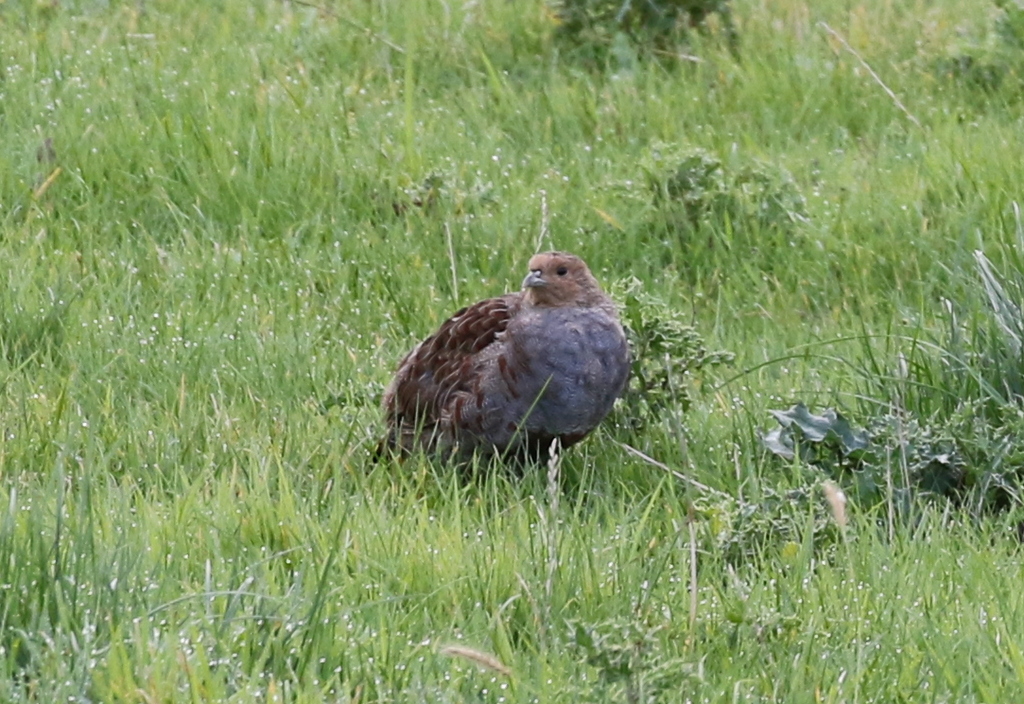 Grey Partridge – on the grazing marsh by Lady Anne’s Drive
Grey Partridge – on the grazing marsh by Lady Anne’s Drive
As we turned west and started to walk along the path on the inland side of the pines, we could hear a Pied Flycatcher calling from the trees. Unfortunately, as we walked through to try to find it, it promptly went quiet. We came out on the edge of the track through to the beach from Lady Anne’s Drive, where the first bird we saw was a Lesser Whitethroat flitting around in the bushes. It seemed to be loosely associated with a mixed tit flock which came along the edge of the trees and disappeared into the pines. It was a great start, but we thought this meant there might be lots of migrants in the woods today.
Continuing on our way west, we heard Treecreeper calling and looked into the trees to see one climbing up the trunk of a very tall pine. We heard Goldcrests calling but they were mostly deeper in the trees and hard to see. We did manage to get on one which was flitting around high up on the edge of the pines. A Jay called from deep in the wood. We had a quick look at Salts Hole, where there were at least three Little Grebes out on the water, diving regularly.
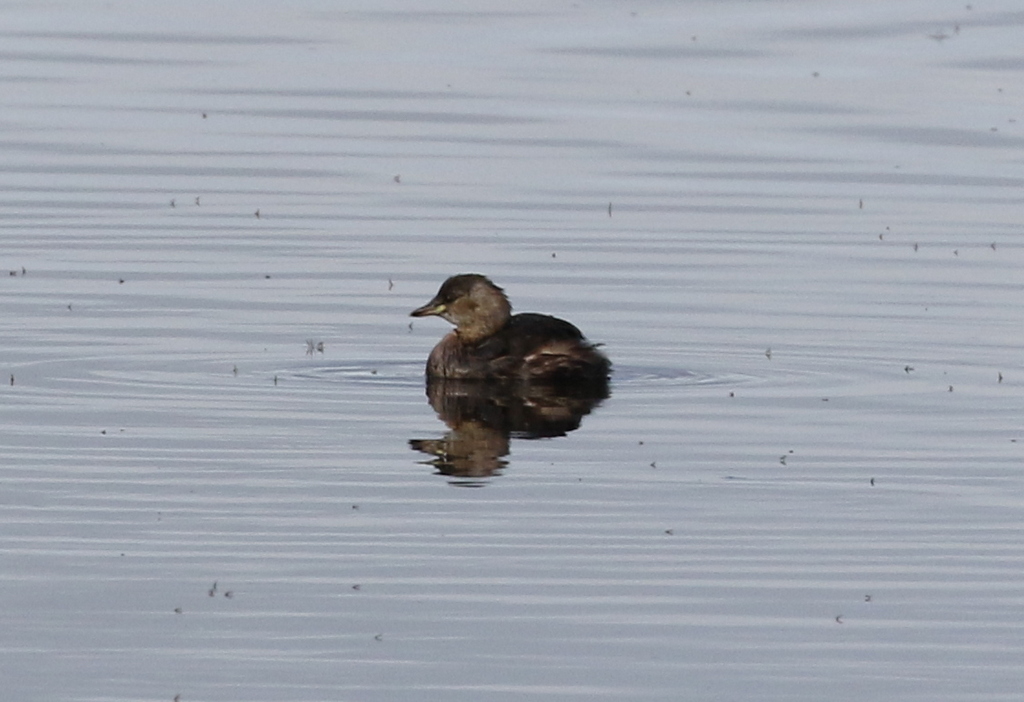 Little Grebe – 1 of at least 3 on Salts Hole
Little Grebe – 1 of at least 3 on Salts Hole
At the gate just before Washington Hide, we stopped to scan the grazing marshes. There were quite a few Pink-footed Geese out in the grass and this gave us an opportunity to look at them in the scope. We could see their dark heads and delicate, dark, pink-banded bills, very different from the carrot-billed Greylag Geese we had seen earlier. A small bird was perched on the top of a line of reeds and kept dropping down into the grass looking for food and flying back up to another perch. Through the scope we could see it was a Whinchat, another autumn migrant. We could see its well-marked pale supercilium.
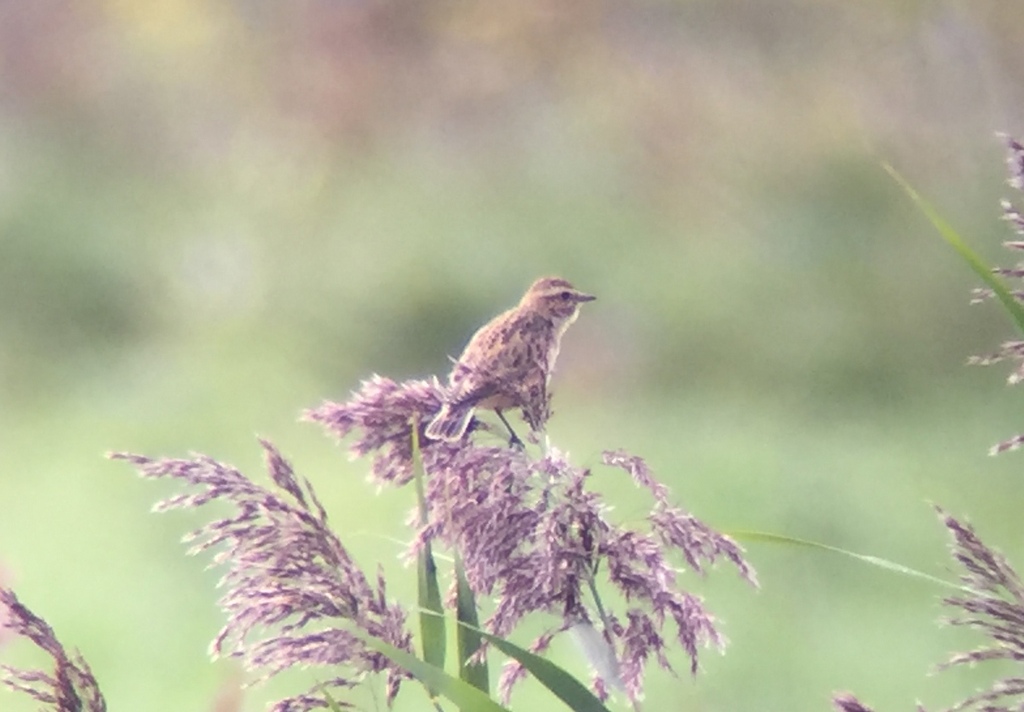 Whinchat – feeding out on the grazing marsh
Whinchat – feeding out on the grazing marsh
The sycamores outside Washington Hide were quiet, no sign of any migrants here, so we turned our attention back to the grazing marsh. There were several ducks down on the pool in front of the hide – mostly Wigeon, Teal and Shoveler, plus a single drake Gadwall. A Pintail appeared briefly, upending out in the middle, showing off its pointed rear end, but quickly disappeared behind the reeds again. A very pale Common Buzzard was perched in a bush further back.
Another couple of birders coming out of the hide told us that they had seen a Great White Egret way off over the back of the grazing marsh, but it had landed out of view. There have been several here all year and they bred this summer for the first time, which was great news. It was presumably one of the other Great White Egrets therefore which walked out from behind the reeds on the pool right in front of us, giving us a great view, especially filling the frame through the scope.
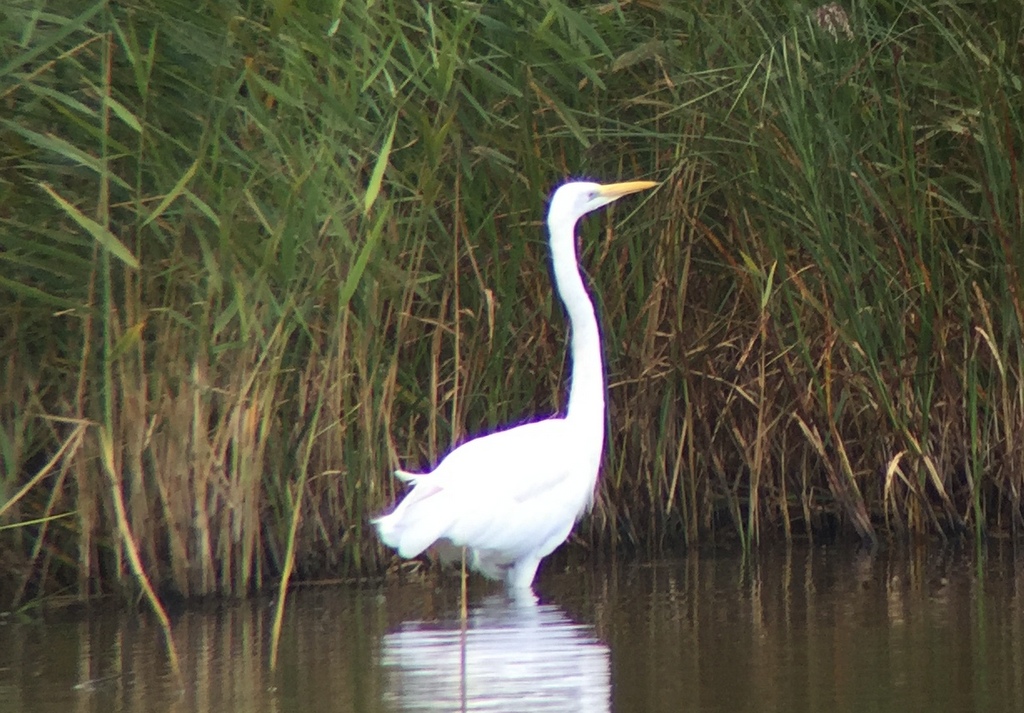 Great White Egret – on the pool right in front of Washington Hide
Great White Egret – on the pool right in front of Washington Hide
The Great White Egret was clearly big and very long necked. We could see its bright orange-yellow bill. It walked very slowly along the reed edge at the back of the pool, occasionally standing stock still and staring down into the water, looking for fish.
Continuing on west, the trees were surprisingly quiet today, with a distinct lack of tit flocks. Perhaps the tits have taken to feeding more in the pines in the recent windy weather. At Meals House, we heard a couple of Chiffchaffs calling, and a Cetti’s Warbler singing. A Jay showed well in the top of a pine tree. We looked up just in time to see a Hobby flying towards us, which continued on straight over our heads.
There had been a report earlier this morning of a Yellow-browed Warbler at the west end of the pines, so we continued straight on past Joe Jordan Hide. We finally found a tit flock half way from there to the end of the trees. We heard the Long-tailed Tits first, and as they came out onto the edge the other tits followed. A couple of Chiffchaffs flitted around in the sallows in the sun, which had started to shine now.
The tits were clinging to the edge of the pines, not coming out properly into the sallows and trees along the path. It seemed like we would not be able to see the whole flock. Then a small warbler flew across the path and landed in the deciduous tree on the south side, and fortunately it was the Yellow-browed Warbler. Unusually, it stayed where it was for a couple of minutes, scratching and wing stretching, which allowed us all to get onto it. We could see its bold pale supercilium and double pale wing bars.
 Yellow-browed Warbler – with the tit flock, near the west end of the pines
Yellow-browed Warbler – with the tit flock, near the west end of the pines
Eventually, the Yellow-browed Warbler flew back across the path and into the sallows on the other side. We thought it might feed there for a while, but it was chased off by one of the Chiffchaffs, and flew up into the trees. We could see it perched high in one of the pines, before it flew again and disappeared back out of view. A Willow Warbler flew across from the sallows too, and then the whole tit flock disappeared back into the pines.
Yellow-browed Warblers breed in Siberia and winter in SE Asia, so North Norfolk might not be the first place you would expect to see one. However, in recent years they have become increasingly common and are now an expected sight at this time of year. It is always great to see the first Yellow-browed Warbler, as it means autumn migration has stepped up a gear.
The pressure was off now, having seen a Yellow-browed Warbler, but we continued on to the end of the pines to see if we could find any other migrants. A Blackcap called from the bushes by the path. There were several dragonflies out enjoying the autumn sunshine – lots of Common Darters, a Ruddy Darter and a few Migrant Hawkers. There were butterflies too – Red Admiral, Comma and several Speckled Wood.
 Common Darter – a female, basking in the sunshine
Common Darter – a female, basking in the sunshine
It was rather quiet at the end of the pines and in the edge of the dunes. We walked round through the trees, but there were next to no birds in the usually attractive spots. We had a quick look out across the grazing marsh from the edge of the dines, and then decided to make our way back, to see if we could find any more interesting birds en route, now that the sun was out.
There was a tit flock high in the tops of the pines at the crosstracks, possibly the one which the Yellow-browed Warbler had been with earlier, but it was hard to see anything clearly up there. We heard more Long-tailed Tits calling just past Meals House, and we got better views of Goldcrest here, but the birds moved quickly back into the trees.
The highlight of the walk back was a Hobby which was hanging in the air over the edge of the pines, catching insects. At one point, it caught something and hung in the air right over our heads eating it, bringing its feet up to its bill so it could devour what it had caught on the wing. Something disturbed the Pink-footed Geese and there was a cacophony of calling as they took off, although we couldn’t see them through the trees. There were clearly a lot more than we had seen earlier now on the grazing marsh.
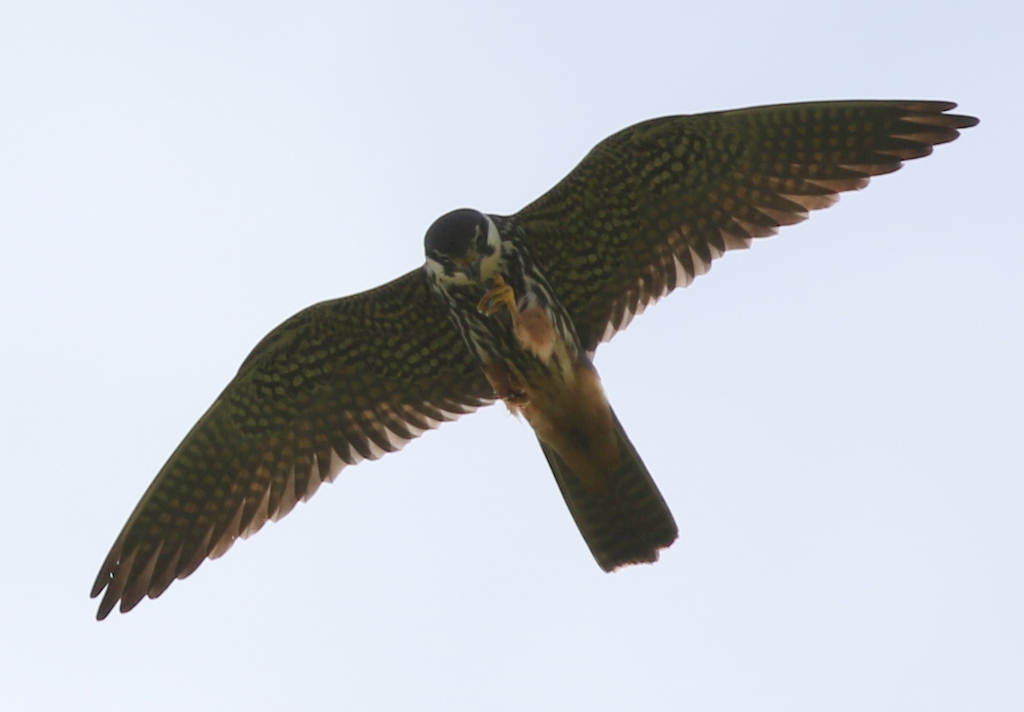 Hobby – eating its insect prey right over our heads
Hobby – eating its insect prey right over our heads
Almost back to Lady Anne’s Drive, we came across another tit flock moving between the pines and the poplars on the south side of the path. At first, all we could see were more tits, Long-tailed Tits, Coal Tits, etc, and a couple of Treecreepers. Then a Yellow-browed Warbler appeared with them, flying out from the edge of the pines and into one of the poplars. It disappeared into the trees, but a few minutes later, as the Long-tailed Tits started to make their way back across the path, it appeared again and we could see it up in the poplar. Our second Yellow-browed Warbler of the day! Then it flew back into the pines and we lost sight of it.
We had intended to eat our lunch at the picnic tables by Lady Anne’s Drive, but we got back to find they were all fenced off. There is a new path being constructed and for the dreaded ‘Health & Safety’ reasons, we were deemed incapable of reaching them without injuring ourselves! We got in the car and drove round to Wells Beach, where we ate lunch in the car park instead.
An Arctic Warbler had been found here earlier in the morning, so after lunch we went into the woods to see if we could see it. Thankfully it was showing well when we arrived at the right spot, and very quickly all the group had seen it. We followed it for about 30 minutes, flicking around in the birches, fluttering and flycatching, and had some great views of it. It would disappear into the leafy trees at times, but after a couple of minutes someone would find it again.
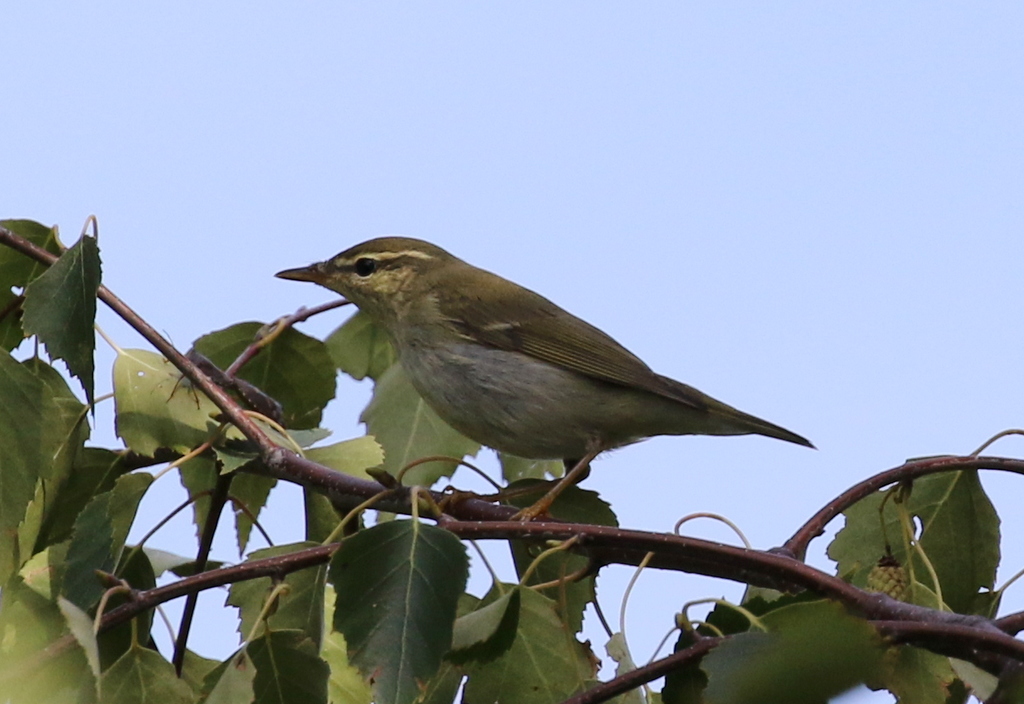 Arctic Warbler – we enjoyed great views of this rarity in Wells Woods today
Arctic Warbler – we enjoyed great views of this rarity in Wells Woods today
Arctic Warbler is a very rare visitor here in Norfolk, although it is an annual visitor to the UK, more commonly on the Northern Isles. They breed in arctic forests, from north Scandinavia eastwards, wintering in SE Asia, so this one was rather off course. They can be very hard to see, but this particular Arctic Warbler was unusually obliging! A great bird to see.
Having spent quite a lot of time in the woods today, we decided to do something different and go looking for some waterbirds for the rest of the afternoon. Stiffkey Fen seemed like a good place to go. It was lovely and sunny now, warm out of the wind, which was still rather blustery. There were not so many birds in the trees and bushes this afternoon, but we did flush several Greenfinches and Chaffinches from the brambles as we passed.
It is hard to see the Fen from the path now, as the reeds and brambles have grown tall over the summer. There are one or two places where you can still get a vantage point, and we could see lots of white blobs huddled up on one of the islands on the Fen, a mix of Spoonbills and Little Egrets. There was nowhere easy to set up the scope here, so we decided to have a look from up on the seawall.
Unfortunately, when we got up onto the seawall, we couldn’t see where the Spoonbills were roosting, it was hidden behind the reeds. There were lots of other things to see on here though. A nice selection of waders included several Greenshanks along with lots of Redshanks and Black-tailed Godwits out on the Fen. A few Ruff were out in the water with them. We got all the waders in the scope to have a good look at them. More Redshanks were gathering in the harbour channel the other side of the seawall, as the tide was coming in now.
There were plenty of ducks on the Fen – Wigeon, Gadwall, Mallard and Teal. A single Pintail was busy upending out at the back. A very large and noisy gaggle of Greylags flew in from the neighbouring field. A Kingfisher flew up from the reeds calling, but was gone in a flash of electric blue, over the seawall and out over the saltmarsh.
We made our way round to have a look in the harbour. The tide was coming in fast now. We heard a Kingfisher call and looked round to see it perched on a mooring chain fixed to the far bank of the channel. It was presumably the bird we had seen earlier, heading in this direction. We had a good look at it through the scope, it was back on to us and we could see the stripe of bright blue down its back. Then it dropped down into the water and caught a fish, flying back up to its perch and beating the fish on the chain repeatedly before swallowing it. Then the Kingfisher flew off up the channel.
 Kingfisher – fishing in the harbour channel
Kingfisher – fishing in the harbour channel
Out around the harbour, we could see lots of waders gathering. They were mostly on the shore round out of view, but we could see a large huddle of Oystercatchers and, further over, a big group of Grey Plover. More waders were flying in across the harbour all the time, forced off from where they had been feeding by the rising water. We saw a little flock of Bar-tailed Godwits, several groups of Dunlin and Ringed Plover, another flock of Grey Plover.
Most of the waders landed out of view, but we did manage to get a few in the scope. A single Dunlin and a lone Turnstone were trying to roost on a spit of mud, but it didn’t take long before it was covered by water and they flew off. Two Sandwich Terns on the same spit were also pushed off by the rising tide. A Curlew was preening down on the front edge of the mud.
While we were scanning through the waders, we found a Great Crested Grebe on the water. A line of Mute Swans swam past us up the channel, with a single Greylag Goose with them. Presumably the Greylag was confused and thought it was a swan!
It was a great spot to stand and take in the view on a sunny autumn afternoon, looking out across the harbour to Blakeney Point beyond. We could see all the seals gathered out on the far point. It made a fitting end to the day, and it was now time to head back. On the way, we stopped along the path and managed to find a spot where we could get the Spoonbills in the scope. As usual, they were mostly asleep, but one or two did wake up briefly, just long enough to flash their spoon-shapes bills before they went back to sleep, at which point it was easier to distinguish them from the white Little Egrets roosting with them.
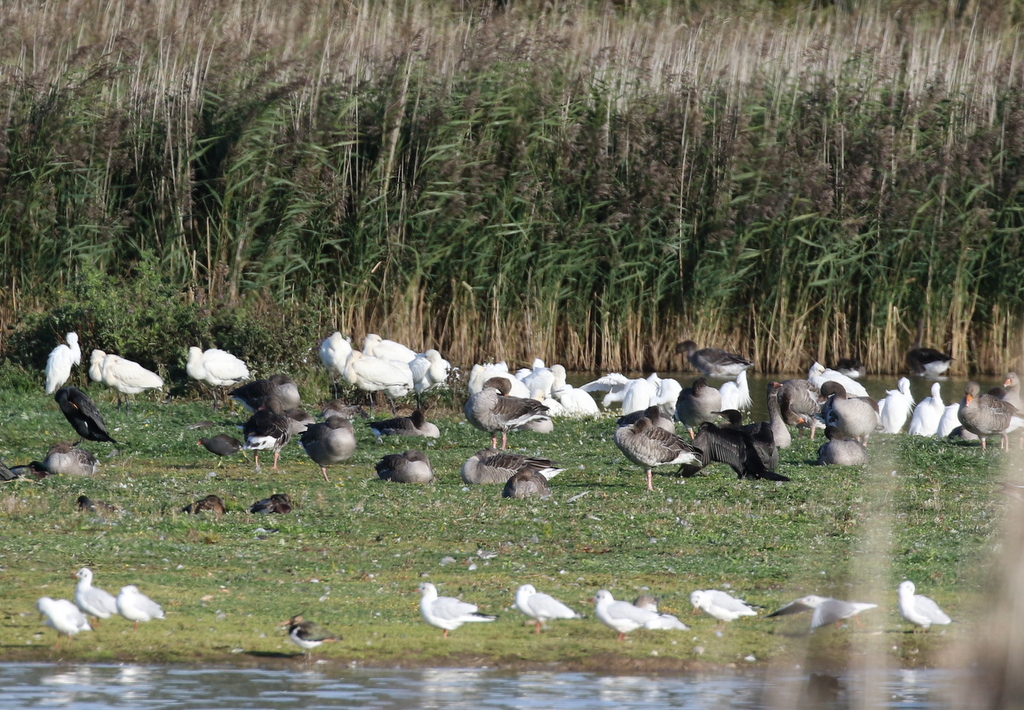 Spoonbills & Little Egrets – roosting on one of the islands at Stiffkey Fen
Spoonbills & Little Egrets – roosting on one of the islands at Stiffkey Fen
It had been a great three days of Autumn birding. The weather had not been anywhere near as bad as forecast, and we had mostly managed to dodge the showers, with the help of a hide or two. We had seen lots of birds, including several exciting ones, scarce Autumn migrants and some of the regular delights of birdwatching in Norfolk.
















